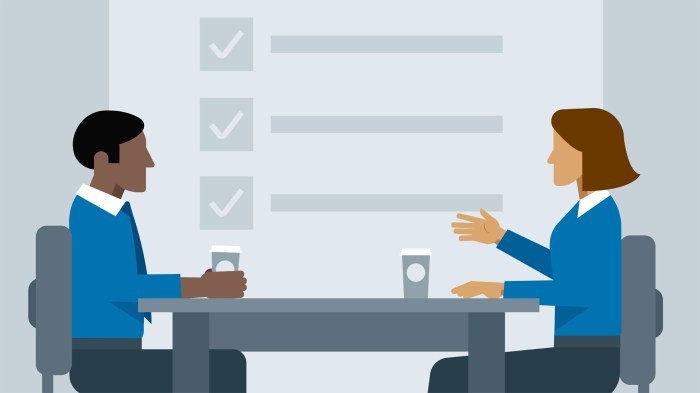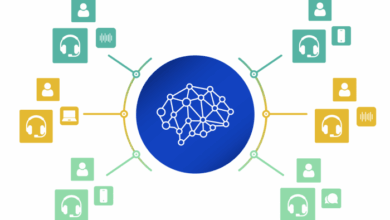
Reasons to change up your one on one meeting location – Reasons to change up your one-on-one meeting location are plentiful. From boosting engagement and focus to fostering creativity and brainstorming, the right environment can dramatically impact your meetings. This post explores the myriad benefits of switching up your meeting spot, examining how different settings affect everything from communication to productivity.
Choosing the ideal meeting location goes beyond mere comfort. It’s about strategically selecting a space that aligns with your team’s goals, whether it’s a quiet corner for deep focus, a vibrant co-working space for brainstorming, or a relaxed café for connecting on a more personal level. Let’s delve into the practicalities and explore how to tailor your meeting spaces to maximize results.
Boosting Engagement and Focus

Switching up your one-on-one meeting location can significantly impact engagement and focus. A stimulating environment can boost creativity and collaboration, while a poorly designed space can hinder productivity. Understanding how different environments affect concentration is key to optimizing these crucial interactions.A thoughtfully chosen meeting location can be a powerful tool for enhancing focus and attentiveness. Careful consideration of factors like noise levels, lighting, and temperature can greatly influence the success of your meeting.
This shift in perspective from a typical office setting to a more dynamic space can spark innovative ideas and lead to more productive outcomes.
Environmental Factors Affecting Focus
Choosing the right meeting environment is crucial for optimizing engagement and attentiveness. The physical setting plays a significant role in shaping the atmosphere and influencing participant behavior. Factors such as noise levels, lighting, and temperature significantly affect concentration levels.
Stimulating Environments for Productivity
Certain locations can naturally promote a productive atmosphere, encouraging collaboration and creative problem-solving. For instance, a well-equipped co-working space with inspiring design elements, a quiet library corner, or even a scenic park can foster a sense of calm and inspiration.
Impact of Noise Levels
Excessive noise can be a major distraction, hindering concentration and impeding effective communication. Open-plan offices, with their inherent noise levels, often create a challenging environment for focused discussions. On the other hand, a quiet room, a private office, or a soundproofed space can foster a more conducive atmosphere for productive dialogue.
Impact of Lighting and Temperature
Adequate lighting is essential for maintaining focus. Harsh or flickering lights can be tiring and distracting, while soft, natural light promotes a sense of calm and clarity. Temperature plays a role as well; an overly warm or cold environment can disrupt concentration. Maintaining a comfortable temperature is key to maximizing productivity.
Comparative Analysis of Meeting Locations
Different meeting locations offer varying degrees of focus and engagement. A well-designed table can help compare the effectiveness of different spaces in supporting productivity.
| Location | Noise Level | Lighting | Temperature | Engagement Potential | Focus Potential |
|---|---|---|---|---|---|
| Open-plan office | High | Fluorescent/Artificial | Variable | Moderate | Low |
| Private Office | Low | Natural/Adjustable | Controlled | High | High |
| Co-working Space | Moderate | Natural/Ambient | Controlled | High | Moderate |
| Library | Low | Natural | Controlled | High | High |
| Park/Outdoor Area | Low | Natural | Variable | High (depending on context) | Moderate (depending on context) |
Enhancing Creativity and Brainstorming

Unleashing creativity and sparking innovative brainstorming sessions is crucial for any team or individual seeking progress. Choosing the right environment plays a pivotal role in fostering a fertile ground for ideas to flourish. Moving beyond the traditional conference room can significantly impact the creative process, encouraging out-of-the-box thinking and diverse perspectives. Alternative meeting spaces offer unique advantages for sparking innovative ideas and fostering collaboration.Different settings can profoundly influence the flow of ideas.
A bustling coffee shop, a tranquil park, or a vibrant co-working space can all contribute to a shift in mindset, inspiring unique approaches to problem-solving. The sensory experiences of each location, from the ambient noise to the visual stimulation, can impact the creative process. The subtle differences in space design, like the availability of natural light or the arrangement of furniture, can all subconsciously influence the way people think and interact.
A comfortable and stimulating environment is essential for creative problem-solving.
Strategies for Fostering Creativity in Alternative Spaces
A well-designed meeting space can significantly enhance creativity. This involves carefully considering factors like the layout of the room, the availability of natural light, and the presence of stimulating visual elements. The incorporation of comfortable seating arrangements, appropriate lighting, and engaging visual elements is crucial for maximizing the potential of the space. Creating an environment that encourages relaxation and free-flowing conversation is vital for unlocking innovative thinking.
Sometimes, a change of scenery is all you need to spark fresh ideas during a one-on-one meeting. Think about it – a quiet coffee shop can be a great alternative to the usual office space, or even a park bench offers a unique perspective. Just as President Obama recently warned graduates about getting overly focused on the tech sector in his address, Obama cautions grads against getting tangled in tech , a different environment can help you approach discussions with a clearer head and ultimately lead to more productive outcomes.
This applies equally to your next one-on-one, so ditch the same old spot and try something new!
Locations for Innovative Thinking and Collaboration
Various locations offer unique advantages for sparking innovative thinking and collaboration. Consider these spaces:
- Co-working spaces: These spaces are designed to foster collaboration and provide a stimulating environment for brainstorming. The shared atmosphere and the presence of diverse individuals often lead to unexpected connections and the generation of innovative ideas. The energy and diversity of individuals in a co-working space can inspire new perspectives and challenge preconceived notions.
- Libraries: The quiet and focused atmosphere of a library can be conducive to deep thought and idea generation. The presence of books and other resources can inspire new connections and perspectives. The quiet, focused environment is conducive to deep thinking and problem-solving.
- Parks: Outdoor spaces, like parks, can provide a refreshing change of pace and inspire a more holistic approach to problem-solving. The fresh air and natural surroundings can stimulate creativity and lead to unexpected insights. The natural beauty and fresh air can invigorate the mind and spark new ideas.
- Coffee shops: The lively and informal atmosphere of a coffee shop can encourage spontaneous interactions and the exchange of ideas. The familiar yet dynamic environment can facilitate quick discussions and spur new connections.
Examples of Meeting Environments and Idea Spark
The environment significantly impacts the creative process. A meeting in a bustling coffee shop, with the ambient noise and diverse people, can lead to unexpected connections and the emergence of novel ideas. Conversely, a serene park setting can inspire a more holistic approach, leading to a broader perspective on the issue. The quiet atmosphere of a library can foster deep contemplation and the development of innovative solutions.
Each setting offers a unique opportunity to spark new ideas.
Impact of Visual Stimulation, Space Design, and Comfort
Visual stimulation, space design, and comfort are all interconnected aspects of fostering creativity. Natural light, strategically placed artwork, or a well-designed layout can significantly impact the flow of ideas. Comfortable seating, appropriate lighting, and the presence of visual elements can all contribute to a more relaxed and productive atmosphere. The interplay of these elements creates a more stimulating and inspiring environment for generating new ideas and perspectives.
Sometimes, a change of scenery can be just what the doctor ordered for those one-on-one meetings. A quiet coffee shop, a vibrant park, or even a cozy co-working space can spark new ideas and improve focus. Like how AMD is aiming to disrupt the ultrabook market with their ultrathins, a fresh meeting location can revitalize the conversation and inspire breakthroughs.
Ultimately, trying different environments for your meetings can bring a new dimension to your collaborative work.
Potential Locations for Brainstorming
| Location | Potential to Spark Creativity | Description |
|---|---|---|
| Co-working space | High | Stimulating environment with diverse individuals and resources |
| Library | Medium | Quiet and focused atmosphere, resources readily available |
| Park | Medium-High | Fresh air, natural surroundings, opportunities for reflection |
| Coffee shop | Medium | Informal atmosphere, opportunities for spontaneous interaction |
| Museum | High | Visual stimulation, diverse perspectives, historical context |
Improving Communication and Connection
Beyond boosting engagement and enhancing creativity, choosing the right meeting location plays a crucial role in fostering genuine connection and open communication among participants. A well-selected environment can significantly impact the quality of interactions, leading to stronger rapport and a more productive meeting experience. The physical space, visual cues, and personal space all contribute to the overall communication dynamic.Effective communication hinges not only on the content exchanged but also on the atmosphere in which it takes place.
Different locations evoke different feelings and contribute to varying levels of trust and openness. Selecting a location that facilitates easy dialogue and strong connections is essential for a successful meeting. This section explores how different environments can cultivate these connections.
Methods for Enhancing Communication and Rapport
The atmosphere of a meeting space can significantly impact the level of rapport and communication among participants. Creating a comfortable and inviting environment encourages open dialogue and fosters a sense of trust. Active listening, respectful communication, and creating a non-judgmental atmosphere are critical for effective communication. Utilizing visual aids and encouraging participants to share their perspectives further contribute to a richer and more meaningful exchange of ideas.
Different Atmospheres and Open Dialogue
Different settings can encourage diverse communication styles and levels of openness. A casual coffee shop, for example, might foster more relaxed and informal discussions, while a formal conference room might be better suited for more structured and detailed exchanges. The key is to choose a location that aligns with the meeting’s objectives and the desired level of interaction.
A well-chosen environment sets the stage for a more effective exchange of ideas.
Locations Fostering Trust and Understanding
Certain locations naturally engender a sense of trust and understanding between participants. A park, with its open and welcoming atmosphere, can promote a relaxed and engaging environment, encouraging more natural interactions. A co-working space, designed for collaboration, can provide a conducive environment for brainstorming and idea sharing. The selection of the location is critical to setting the tone for trust and understanding.
Impact of Physical Proximity, Visual Cues, and Personal Space
Physical proximity, visual cues, and personal space play crucial roles in communication dynamics. Close proximity can foster more intimate interactions, while a larger space can promote a more formal or distanced atmosphere. Visual cues, such as the presence of art or natural light, can influence mood and perceptions. Respecting personal space is paramount to creating a comfortable and inclusive environment.
Proper consideration of these elements is crucial for facilitating productive communication.
Comparison of Locations and Impact on Communication Quality
Different locations have varying effects on communication quality. A quiet library, for example, can encourage focused discussions, while a bustling cafe can promote more spontaneous and creative interactions. The choice of location should align with the specific needs and goals of the meeting. Consider the level of focus and interaction required for the meeting and select the environment that best supports those needs.
Table of Locations and Communication Potential
| Location | Potential to Improve Communication and Connection | Description |
|---|---|---|
| Quiet Library | High | Promotes focused discussions and deep engagement. |
| Park | Medium-High | Encourages relaxed and natural interactions. |
| Co-working Space | High | Facilitates collaboration and idea-sharing. |
| Formal Conference Room | Medium | Supports structured and detailed exchanges. |
| Cafe | Medium-High | Encourages spontaneous and creative interactions. |
Managing Different Needs and Preferences
One-on-one meetings are crucial for effective communication and collaboration, but the success of these interactions hinges on several factors. Beyond the usual considerations of engagement and focus, recognizing and accommodating diverse needs and preferences among participants is vital for creating a truly inclusive and productive environment. Understanding how to tailor meeting locations to different needs ensures that everyone feels comfortable, heard, and able to contribute their best work.Successfully navigating diverse needs requires a thoughtful approach to location selection.
This involves considering factors beyond just convenience, such as accessibility, inclusivity, and comfort levels. Flexibility and adaptability are key to ensuring all participants feel valued and empowered to contribute fully to the discussion.
Sometimes, a change of scenery can totally revamp your one-on-one meetings. Think about it – a fresh perspective often leads to fresh ideas. For example, a new coffee shop or a quiet park could be just the boost you need to spark creativity and collaboration. This is similar to how a smart bed, like the one featured in the article smart bed could give patients a lift when they need it , can revolutionize patient care.
A change of location in these cases can significantly impact outcomes. So, next time you schedule a meeting, consider switching things up for a more productive and engaging experience.
Catering to Accessibility Needs
Understanding and accommodating diverse needs, particularly those related to accessibility, is paramount in fostering inclusivity. Meeting spaces must be designed to accommodate individuals with mobility impairments, visual or auditory challenges, or other physical limitations. This involves providing ramps, accessible restrooms, assistive listening devices, and clear signage, among other features. Prioritizing accessibility ensures that no one feels excluded or disadvantaged from participating in the meeting.
Ensuring Inclusivity and Comfort Levels
Inclusivity goes beyond mere physical accessibility. It encompasses creating a comfortable and welcoming atmosphere for all participants, regardless of background, culture, or personal preferences. This might involve providing quiet spaces for those needing focused time, or offering diverse refreshments that cater to dietary restrictions or preferences. Choosing a location that reflects the diverse backgrounds of the attendees fosters a sense of belonging and respect.
Examples of Inclusive Meeting Locations
Several locations can effectively accommodate diverse needs and preferences. For example, a co-working space with multiple work pods, adaptable seating arrangements, and accessible restrooms can cater to various needs. Similarly, a local café with a dedicated quiet zone, comfortable seating, and a variety of food options can provide a welcoming and inclusive environment.
Flexibility and Adaptability in Location Selection
Flexibility and adaptability are critical components of effective meeting management. The ability to adjust the meeting location based on the specific needs of the participants can greatly enhance the overall experience. Consider factors like the time of day, the nature of the discussion, and the individual preferences of those attending. This adaptability ensures the location supports the meeting objectives and enhances the participants’ comfort and engagement.
Strategies for Ensuring Participant Comfort and Inclusion
Several strategies can help ensure all participants feel comfortable and included. Communicating the location’s accessibility features and inclusivity aspects beforehand is crucial. Furthermore, offering a choice of locations, or the flexibility to modify the location depending on the meeting’s evolution, can be extremely helpful. Involving participants in the decision-making process, if possible, can help foster a sense of ownership and shared responsibility.
Illustrative Table of Locations and Accessibility Features
| Location Type | Accessibility Features | Inclusivity Factors |
|---|---|---|
| Co-working Space | Ramps, accessible restrooms, adjustable seating, quiet zones | Diverse work pods, variety of refreshments, communal spaces |
| Library Meeting Room | Quiet zones, accessible restrooms, comfortable seating | Quiet environment, ample space, potential for group work |
| Local Café | Accessible entrances, restrooms, often adaptable seating | Variety of food options, potential quiet zones, relaxed atmosphere |
| Park or Outdoor Venue | Depending on the park, potential for accessible paths and seating | Fresh air, natural setting, opportunities for brainstorming |
Leveraging Technology and Accessibility
Technology has revolutionized the way we connect and collaborate, and this extends seamlessly to one-on-one meetings. Utilizing the right tools and understanding the nuances of different locations can significantly boost productivity and engagement during these crucial interactions. From ensuring reliable internet connectivity to optimizing audio-visual equipment, the role of technology in facilitating successful meetings in diverse settings is paramount.
The Role of Technology in Facilitating Meetings
Technology empowers remote and hybrid work models by enabling real-time communication and collaboration. Platforms like Zoom, Google Meet, and Microsoft Teams facilitate seamless interactions, allowing participants to connect regardless of their physical location. These tools often provide features like screen sharing, document collaboration, and instant messaging, enriching the meeting experience.
Leveraging Technology for Seamless Communication and Collaboration
Effective communication in diverse environments hinges on reliable technology. Ensuring a stable internet connection is crucial for video conferencing, online document sharing, and instant messaging. Participants should be aware of potential connectivity issues in their specific locations and have backup plans in place. Choosing the right technology for the specific environment is vital. For example, a meeting in a coffee shop might require a more robust Wi-Fi connection than a meeting in a well-equipped office space.
Examples of Locations with Optimal Technological Support, Reasons to change up your one on one meeting location
Well-equipped meeting rooms in co-working spaces, modern offices, and even some public libraries often boast reliable internet access, high-quality audio-visual equipment, and appropriate technical support. Hotels with business centers frequently provide similar amenities, catering to the needs of travelers and remote workers. These locations are generally equipped to handle the demands of virtual meetings, minimizing potential disruptions.
Importance of Internet Connectivity, Audio-Visual Equipment, and Other Technological Needs
Robust internet connectivity is paramount for seamless video conferencing and file sharing. High-quality audio-visual equipment, such as clear microphones and webcams, is essential for a professional and engaging experience. Additional technological needs might include suitable presentation software, shared document platforms, and reliable power sources. Consider factors like signal strength and interference when choosing a meeting location, especially if relying on public Wi-Fi.
Strategies for Troubleshooting Technology Issues
Troubleshooting technology problems in different locations requires a proactive approach. Establish clear communication channels with participants beforehand. Provide detailed instructions on how to access the meeting platform and share documents. Test the technology in advance to identify potential issues. Have a backup plan in case of technical difficulties, such as a secondary communication method (e.g., phone call).
Familiarize yourself with the troubleshooting resources provided by the chosen platform.
Technology Availability in Different Locations
| Location Type | Internet Connectivity | Audio-Visual Equipment | Other Technologies |
|---|---|---|---|
| Co-working Space | Generally good, but can vary by location | Often well-equipped with high-quality microphones and cameras | Access to presentation software, document sharing |
| Home Office | Dependent on home internet infrastructure | Variable; may require external microphones and cameras | Software access, reliable power supply |
| Public Library | Typically available, but may be crowded or have limited bandwidth | Often equipped with basic equipment | Limited access to advanced tools |
| Hotel Business Center | Usually reliable, high-speed connections | Equipped with meeting room technology | Access to a variety of tools and services |
| Coffee Shop | Public Wi-Fi, variable quality and reliability | Limited equipment options | Potential for interruptions and noise |
Optimizing Productivity and Efficiency
Choosing the right meeting location significantly impacts productivity. A well-chosen space can boost focus, minimize distractions, and enhance collaboration, ultimately leading to more efficient task completion. Conversely, an inappropriate setting can lead to wasted time, decreased engagement, and a less productive outcome. This exploration delves into strategies for optimizing productivity in various meeting environments.Optimizing meeting locations isn’t just about finding a comfortable room; it’s about creating an environment that supports focused work and facilitates clear communication.
This involves understanding the impact of environmental factors on concentration, selecting spaces conducive to task completion, and implementing strategies to minimize distractions. The right location can make the difference between a productive meeting and a wasted hour.
Environmental Factors Affecting Task Completion
Environmental factors like lighting, noise levels, and temperature profoundly affect concentration and time management. Poor lighting can lead to eye strain and fatigue, while excessive noise can disrupt focus and make it difficult to concentrate. Temperature extremes can also hinder productivity. Maintaining a comfortable and controlled environment is crucial for maximizing focus and efficiency during meetings. For example, a brightly lit, overly warm room with constant background noise will significantly impede concentration compared to a space with soft lighting, a moderate temperature, and minimal background noise.
Locations Promoting Focused Work
Certain locations are naturally conducive to focused work and task completion. Libraries, co-working spaces with dedicated quiet zones, and even well-appointed home offices can provide the necessary environment for productive meetings. The presence of natural light, a quiet atmosphere, and the absence of disruptive elements can contribute significantly to focused work. For instance, a quiet library with ample space and comfortable seating is an ideal location for focused meetings, as is a co-working space designed with designated quiet zones.
Importance of Clear Boundaries and Designated Spaces
Clearly defined boundaries, including designated spaces and times for meetings, are essential for optimizing productivity. This helps establish a dedicated work zone, separating work time from personal time, thus minimizing distractions. Well-defined meeting rooms, whether physical or virtual, are vital in ensuring that meetings remain focused and productive. For example, a clearly marked meeting room, along with established start and end times, helps participants focus on the task at hand, while designated quiet zones in co-working spaces allow for focused work without disruptions.
Strategies for Minimizing Distractions
Minimizing distractions is critical for maximizing concentration in alternative meeting spaces. This includes turning off notifications, using noise-canceling headphones, and establishing clear meeting agendas to guide discussions. Furthermore, ensuring adequate lighting and temperature control, as well as using designated meeting rooms, can greatly contribute to minimizing distractions. For example, using noise-canceling headphones during meetings in a shared workspace can greatly reduce distractions.
Turning off notifications and establishing a clear meeting agenda are equally important steps in minimizing distractions.
Comparison of Meeting Locations
| Location | Potential to Enhance Productivity | Pros | Cons |
|---|---|---|---|
| Library | High | Quiet environment, access to resources | Limited space, potential for interruptions |
| Co-working space (quiet zone) | High | Collaboration opportunities, various amenities | Potential for noise from other members |
| Home office | Medium to High | Flexibility, control over environment | Potential for distractions from family/household members |
| Dedicated meeting room | High | Designated space, clear boundaries | May not be available or accessible |
| Café (quiet corner) | Low to Medium | Stimulating environment, casual atmosphere | High noise levels, potential interruptions |
Addressing Practical Considerations
Choosing the right meeting location is crucial for success. Beyond the intangible benefits of ambiance and connection, practical factors like travel time, cost, and accessibility significantly impact the effectiveness of your meetings. Understanding these considerations ensures a productive and efficient experience for everyone involved.Logistics and practicality are essential for maximizing the value of your meetings. A well-planned meeting location considers not only the desired atmosphere but also the practicalities that can either enhance or hinder the meeting’s overall success.
Ignoring these elements can lead to wasted time, increased stress, and ultimately, a less productive outcome.
Travel Time and Cost
Understanding the travel time to a meeting location is crucial. Prolonged travel can lead to fatigue and reduced focus, diminishing the meeting’s effectiveness. Factor in both direct travel time and potential delays due to traffic or unforeseen circumstances. Similarly, the cost of travel (including transportation, parking, and potentially accommodation) should be considered. A location that requires extensive travel, especially for multiple participants, can quickly become financially prohibitive.
Accessibility and Scheduling Flexibility
Accessibility factors include not only physical access for people with disabilities but also ease of reaching the location for everyone. Consider the availability of public transportation, parking options, and proximity to other essential services. Similarly, scheduling flexibility is paramount. Ensure the chosen location is readily available on the desired dates and times. Also, be mindful of potential disruptions like unforeseen events, weather conditions, or unexpected conflicts.
Examples of Effective and Practical Locations
Numerous locations can effectively serve as meeting spaces. A well-equipped co-working space, for instance, provides a blend of collaboration tools and flexibility. Alternatively, a neutral location, like a neutral conference room in a business center, can be an excellent option, especially for meetings involving multiple stakeholders with different travel needs.
Minimizing Potential Issues
To minimize potential issues, a thorough site visit is recommended before booking a meeting space. Assess the room’s size, acoustics, and technological capabilities to ensure they align with your needs. It’s also advisable to communicate with the venue management in advance about any potential disruptions or changes to the schedule. Establish clear communication protocols to mitigate issues if they arise during the meeting.
Location Comparison Table
| Location | Cost | Accessibility | Travel Time (Avg.) |
|---|---|---|---|
| Central Business District Conference Room | Medium | High | Low-Medium |
| Boutique Hotel Conference Room | High | Medium | Low-Medium |
| Local Co-working Space | Low-Medium | Medium | Low |
| Remote Cafe | Low | Medium-High | Medium-High |
Note: Cost is relative to the size and features of the location. Accessibility reflects proximity to public transport and facilities. Travel time is approximate and depends on individual location and traffic conditions.
Final Conclusion: Reasons To Change Up Your One On One Meeting Location
Ultimately, the key to successful one-on-one meetings lies in understanding your team’s needs and preferences. By thoughtfully considering factors like engagement, creativity, communication, and accessibility, you can craft a meeting experience that yields maximum results and leaves everyone feeling heard, understood, and productive. So, ditch the predictable meeting room and explore the exciting potential of alternative spaces. The right location can transform your interactions, fostering deeper connections and leading to more innovative outcomes.






